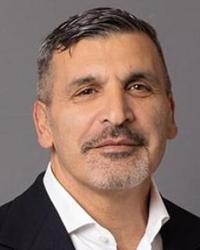Fibroids After Menopause: What to Do When Symptoms Won’t Let Up

March 04, 2025
Menopause means the end of periods and pregnancy concerns. But for some, it may have another benefit: relieving fibroids.
Fibroids are mainly noncancerous growths that attach to the wall of the uterus. They can be as small as a fruit seed or as large as a watermelon. In some segments of the population, up to 80 percent of women will have fibroids by age 50.
Estrogen may feed fibroid growth, says Yitzhack Asulin, M.D., director of robotic surgery at Pascack Valley Medical Center. So, when estrogen drops in menopause, fibroids usually shrink. But fibroids often develop for years before causing symptoms such as:
- Heavy bleeding
- Pelvic or lower back pain
- Frequent urination
- Bloating
- Constipation
- Painful sex
For that reason, some may not feel their effects until menopause is on the horizon.
Hormone Connection
“Scientists don’t know exactly why fibroids develop,” Dr. Asulin says. However, many have a family history of the condition. We do know that hormones affect fibroids. “We think of hormones as having similar effects as growth factors, affecting organs such as the uterus, fallopian tubes and cervix,” he says.
Fibroid growth usually slows or reverses in menopause. But other changes can affect how they feel. “Menopause can cause so many effects on the reproductive system, including thinning the vaginal walls,” Dr. Asulin says. “So if there’s any mass in the pelvic area, you suddenly feel it more.”
This can cause symptoms like:
- A sense of pressure or heaviness in the pelvis
- Feeling like you have to pee too often or leaking urine with physical activity
- Pain during sex
Diagnosis and Treatment
If you or your doctor think you have fibroids, you should have a physical exam. “Your doctor may even be able to feel large fibroids through your abdomen or a pelvic exam,” Dr. Asulin says. Next, your doctor will measure the fibroids and pinpoint their location, size and consistency with an ultrasound. If your doctor thinks a fibroid may be cancerous, they might also order an MRI, though this is very uncommon.
If you do have fibroids, your doctor may prescribe an estrogen-reducing medicine called leuprolide. This will temporarily shrink your fibroids and stop heavy bleeding. The medication is only for short-term use.
If your fibroid symptoms don’t go away, and you are not planning to become pregnant, other noninvasive treatments you may try include:
- Transcervical radiofrequency ablation, which shrinks fibroids using heat energy
- Endometrial ablation, which uses heat to remove the lining of the uterus to relieve heavy menstrual bleeding
- Fibroid embolization, which cuts off the blood supply to fibroids, causing them to shrink
If these treatments don’t relieve severe symptoms, surgery may be the best course. Surgical options to treat fibroids are:
- Myomectomy, which removes only the fibroids but leaves the uterus intact
- Hysterectomy, which removes the entire uterus, including the fibroids
Many of these procedures can be done robotically. “This means less bleeding, pain and risk of infection – even for large fibroids,” Dr. Asulin says.
“Robotic surgery has completely changed the equation compared to 20 or 30 years ago,” he says. “Fibroid removal once required a big scar and a long hospital stay. Now we can tell patients they can go home the next morning and will be completely back on their feet within days.”
If you’re getting close to menopause and have been diagnosed with fibroids or think you may have them, speak with your gynecologist. You don’t have to live with the pain and discomfort of fibroids.
Next Steps & Resources:
- Meet our source: Yitzhack Asulin, M.D.
- Make an appointment with a gynecological surgeon near you or call 800-822-8905.
- Learn more about women's health at Hackensack Meridian Health.
The material provided through HealthU is intended to be used as general information only and should not replace the advice of your physician. Always consult your physician for individual care.







